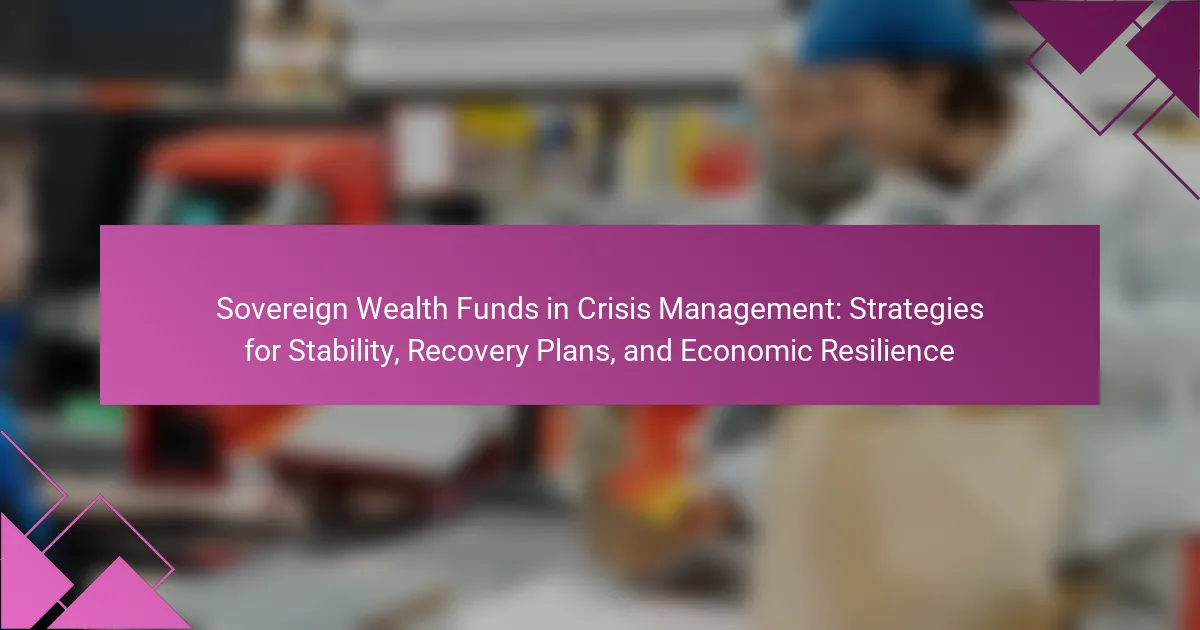
What are Sovereign Wealth Funds and their Role in Crisis Management?
Sovereign Wealth Funds (SWFs) are state-owned investment funds or entities. They manage national savings for the purposes of investment. SWFs play a crucial role in crisis management by providing financial stability during economic downturns. They can invest in distressed assets, supporting market liquidity. SWFs often act as stabilizers, mitigating the impact of financial crises. For instance, during the 2008 financial crisis, several SWFs invested in struggling banks to restore confidence. Their long-term investment horizon allows them to weather short-term volatility effectively. This strategic approach helps in economic recovery and resilience.
How do Sovereign Wealth Funds operate during economic crises?
Sovereign Wealth Funds (SWFs) operate as stabilizing mechanisms during economic crises. They provide liquidity to markets by investing in distressed assets. This investment helps stabilize financial systems and restore investor confidence. SWFs often take advantage of lower asset prices during downturns. They may also support domestic industries to prevent job losses. In some cases, SWFs act as a counter-cyclical tool, deploying capital when private investment declines. For example, during the 2008 financial crisis, SWFs invested over $100 billion globally to support banks and companies. Their strategic investments are aimed at long-term recovery and economic resilience.
What specific functions do these funds serve in stabilizing economies?
Sovereign Wealth Funds (SWFs) serve several specific functions in stabilizing economies. They provide liquidity during financial crises by investing in distressed assets. This investment helps stabilize market prices and restore confidence. SWFs also support fiscal stability by providing a buffer against economic shocks. They can finance government deficits without increasing debt levels. Additionally, SWFs promote long-term economic growth by investing in infrastructure and development projects. This investment creates jobs and stimulates economic activity. Historical examples include the Norway Government Pension Fund, which has successfully weathered economic downturns. Overall, SWFs play a crucial role in enhancing economic resilience through strategic investments and fiscal support.
How do Sovereign Wealth Funds differ from other investment funds?
Sovereign Wealth Funds (SWFs) differ from other investment funds primarily because they are state-owned investment vehicles. SWFs are established by governments to manage national savings and stabilize the economy. They typically invest in a diverse range of assets, including stocks, bonds, and real estate, with a long-term investment horizon. In contrast, other investment funds, such as mutual funds or hedge funds, are usually privately managed and focus on maximizing returns for individual investors.
Moreover, SWFs often have a mandate to support national economic goals, such as funding infrastructure projects or stabilizing currency fluctuations. According to the International Forum of Sovereign Wealth Funds, there are over 90 SWFs globally, managing more than $9 trillion in assets. This scale and purpose set them apart from other investment funds, which primarily aim for profit generation.
Why are Sovereign Wealth Funds critical for economic resilience?
Sovereign Wealth Funds (SWFs) are critical for economic resilience because they provide financial stability during economic downturns. SWFs are government-owned investment funds that manage national savings for various purposes. They can act as a buffer against economic shocks by providing liquidity in times of crisis. For example, during the 2008 financial crisis, several SWFs invested in struggling banks to stabilize the financial system. Additionally, SWFs help diversify national investments, reducing reliance on volatile revenue sources like oil. The assets held by SWFs can be used to fund public services and infrastructure, supporting long-term economic growth. In 2020, the International Monetary Fund reported that SWFs were instrumental in helping countries mitigate the impacts of the COVID-19 pandemic. Thus, SWFs play a vital role in enhancing a nation’s economic resilience.
What historical examples illustrate their importance in crises?
Sovereign Wealth Funds (SWFs) have played crucial roles in crises. One significant example is the Government of Singapore Investment Corporation (GIC) during the 2008 financial crisis. GIC invested $6 billion in Citigroup to stabilize the bank. Another example is the Norway Government Pension Fund, which provided liquidity during the European debt crisis. It helped maintain economic stability in Norway by supporting local markets. These actions illustrate how SWFs can mitigate financial instability during economic downturns.
How do these funds contribute to long-term economic stability?
Sovereign wealth funds contribute to long-term economic stability by providing a financial buffer during economic downturns. These funds invest in diverse assets, which helps mitigate risks associated with market volatility. By stabilizing national revenues, they ensure consistent funding for public services and infrastructure. Historical examples show that countries with sovereign wealth funds, like Norway, have maintained economic resilience during crises. In 2020, during the COVID-19 pandemic, such funds helped countries like Singapore and Abu Dhabi to support their economies through targeted investments. This strategic approach fosters investor confidence and attracts foreign investment. Consequently, sovereign wealth funds play a crucial role in enhancing economic stability over the long term.

What Strategies do Sovereign Wealth Funds Employ for Stability?
Sovereign wealth funds employ diversification, risk management, and long-term investment strategies for stability. Diversification involves spreading investments across various asset classes and geographies. This reduces exposure to any single market or economic downturn. Risk management practices include thorough analysis and monitoring of investments. They often utilize hedging techniques to mitigate potential losses. Long-term investment strategies focus on sustained growth rather than short-term gains. Sovereign wealth funds typically have investment horizons spanning decades. These strategies collectively enhance their resilience during economic fluctuations. For example, Norway’s Government Pension Fund Global has maintained stability through a diversified portfolio.
How do Sovereign Wealth Funds assess risks during crises?
Sovereign Wealth Funds assess risks during crises by employing a multi-faceted risk management framework. They analyze macroeconomic indicators to understand the broader economic environment. This includes monitoring GDP growth, inflation rates, and unemployment figures. They also evaluate geopolitical risks that may impact investments. Stress testing is a common practice to simulate various crisis scenarios. This helps in understanding potential impacts on portfolio performance. Additionally, they focus on liquidity assessments to ensure they can meet obligations during downturns. Historical data analysis provides insights into past crises and their effects on assets. By combining these strategies, Sovereign Wealth Funds enhance their resilience during turbulent times.
What metrics are used to evaluate economic conditions?
Key metrics used to evaluate economic conditions include Gross Domestic Product (GDP), unemployment rates, inflation rates, and consumer confidence indices. GDP measures the total economic output of a country, reflecting its economic health. Unemployment rates indicate the percentage of the labor force that is jobless, affecting consumer spending. Inflation rates measure the rate at which prices for goods and services rise, impacting purchasing power. Consumer confidence indices gauge how optimistic consumers feel about the economy, influencing their spending behavior. These metrics provide a comprehensive view of economic performance and stability, essential for assessing the effectiveness of sovereign wealth funds in crisis management.
How do geopolitical factors influence investment decisions?
Geopolitical factors significantly influence investment decisions by affecting market stability and risk assessments. Investors often evaluate political stability, trade relations, and regulatory environments before committing capital. For instance, tensions in regions like the Middle East can lead to increased oil prices, impacting global markets. Additionally, changes in government policies can alter the investment landscape, as seen with trade tariffs imposed during U.S.-China relations. Historical events, such as Brexit, have also demonstrated how geopolitical shifts can lead to market volatility, prompting investors to reassess their strategies. Overall, the interplay between geopolitical dynamics and investment decisions is critical for assessing potential returns and risks.
What are the key investment strategies used by Sovereign Wealth Funds?
Sovereign Wealth Funds (SWFs) primarily utilize diversification, long-term investment, and risk management as key investment strategies. Diversification involves spreading investments across various asset classes, such as equities, bonds, real estate, and infrastructure. This strategy reduces risk and enhances potential returns by not relying on a single investment type. Long-term investment focuses on holding assets for extended periods, allowing SWFs to benefit from market growth and compounding returns. Risk management is essential, as SWFs analyze potential risks and adjust their portfolios accordingly to maintain stability during market fluctuations. These strategies are supported by historical performance data, showing that diversified portfolios tend to outperform concentrated investments over time.
How do diversification and asset allocation play a role?
Diversification and asset allocation are critical strategies for managing risk in sovereign wealth funds. Diversification involves spreading investments across various asset classes to minimize exposure to any single economic event. This strategy reduces volatility and potential losses during market downturns. Asset allocation refers to the distribution of investments among different categories, such as equities, bonds, and real estate. Proper asset allocation aligns with the fund’s risk tolerance and investment objectives. Historical data shows that diversified portfolios tend to outperform non-diversified ones over time, as they are better positioned to withstand market fluctuations. For instance, during the 2008 financial crisis, diversified funds demonstrated greater resilience compared to those concentrated in specific sectors.
What types of assets do these funds typically invest in during crises?
Sovereign wealth funds typically invest in safe-haven assets during crises. These assets include government bonds, particularly from stable countries. They may also invest in gold and other precious metals. Equities in defensive sectors like utilities and healthcare are often targeted. Real estate in prime locations can also be attractive. Cash and cash equivalents are maintained for liquidity. These strategies help preserve capital and provide stability. Historical data shows that funds increased allocations to these assets during past economic downturns.

What Recovery Plans do Sovereign Wealth Funds Implement?
Sovereign wealth funds implement recovery plans that focus on asset reallocation and diversification. These plans aim to stabilize investments during economic downturns. Funds often increase liquidity to respond to market volatility. They may also invest in distressed assets to capitalize on lower prices. Strategic partnerships with other financial institutions can enhance recovery efforts. Funds analyze market trends to identify growth opportunities post-crisis. Historical examples show that funds like Norway’s Government Pension Fund Global have successfully navigated economic challenges. Their recovery strategies often include a mix of long-term investments and short-term liquidity management.
How do Sovereign Wealth Funds adjust their portfolios post-crisis?
Sovereign Wealth Funds (SWFs) adjust their portfolios post-crisis by re-evaluating asset allocations. They often shift investments toward more stable, less volatile assets. This includes increasing allocations to bonds and cash equivalents. SWFs may also diversify into alternative investments, such as real estate or infrastructure.
The goal is to mitigate risks associated with market fluctuations. Historical data shows that during the 2008 financial crisis, many SWFs increased their exposure to safer assets. This strategy helps maintain liquidity and protect capital during uncertain times. Additionally, SWFs may reassess their investment strategies to align with long-term economic forecasts. These adjustments are crucial for ensuring economic resilience and stability in the aftermath of a crisis.
What strategies are used for rebalancing investments?
Rebalancing investments involves several strategies. One common strategy is the periodic rebalancing approach. This method requires investors to review their asset allocation at regular intervals, such as quarterly or annually. Investors sell over-performing assets and buy under-performing ones to maintain the desired allocation.
Another strategy is the threshold rebalancing approach. This method triggers rebalancing when asset allocations deviate from predetermined thresholds. For example, if an asset class exceeds a 5% deviation from its target, rebalancing occurs.
A tactical rebalancing strategy involves making adjustments based on market conditions. Investors may shift allocations based on economic indicators or market trends. This approach requires active monitoring of market conditions.
Lastly, some investors use automated rebalancing tools. These tools can help maintain target allocations without manual intervention. They automatically execute trades based on set parameters.
These strategies ensure that investments align with risk tolerance and financial goals. Regular rebalancing can enhance long-term investment performance and reduce risk.
How do funds prioritize sectors for recovery investments?
Funds prioritize sectors for recovery investments based on economic impact and potential for growth. They analyze sectors that have been severely affected by crises. Data on employment rates, GDP contributions, and recovery timelines influence their decisions. Funds often focus on industries like healthcare, technology, and renewable energy. These sectors show resilience and promise for future development. Historical data indicates that investments in these areas yield significant returns. For instance, during the COVID-19 pandemic, funds increased allocations to healthcare and technology. This strategy aligns with long-term economic stability and growth objectives.
What lessons have been learned from past recovery efforts?
Past recovery efforts have highlighted the importance of diversification in investment strategies. Sovereign Wealth Funds (SWFs) that diversified their portfolios fared better during economic downturns. For instance, the 2008 financial crisis demonstrated that funds with a mix of asset classes reduced risk exposure. Additionally, timely government intervention was crucial in stabilizing economies. Countries that acted quickly to deploy SWF resources experienced faster recovery rates. Historical data shows that transparency and accountability in fund management build public trust, facilitating smoother recovery processes. Lessons also indicate that collaboration with international financial institutions enhances recovery efforts. Overall, these insights emphasize the need for proactive planning and responsive strategies in crisis management.
How have Sovereign Wealth Funds adapted their strategies over time?
Sovereign Wealth Funds have adapted their strategies over time by diversifying their investment portfolios. Initially focused on traditional asset classes, they now include alternatives like private equity and real estate. This shift aims to enhance returns and mitigate risks associated with market volatility. Increased emphasis on sustainable and responsible investing has also emerged. Many funds are incorporating ESG (Environmental, Social, and Governance) criteria into their decision-making processes. This adaptation reflects a growing awareness of global challenges such as climate change. Additionally, funds have improved their risk management frameworks to navigate economic uncertainties. The global financial crisis of 2008 prompted many Sovereign Wealth Funds to reassess their strategies. They have since adopted a more proactive approach to crisis management and economic resilience.
What best practices have emerged from successful recovery plans?
Successful recovery plans emphasize clear communication, stakeholder engagement, and adaptability. These elements ensure that all parties understand the recovery process and their roles in it. Regular assessments of the recovery plan’s effectiveness are crucial. This allows for timely adjustments based on real-time data and feedback. Additionally, leveraging diversified investment strategies helps mitigate risks. Research shows that funds with diversified portfolios recover faster from crises. Collaborative partnerships with local governments and communities enhance resource allocation. This fosters trust and ensures that recovery efforts align with community needs. Finally, implementing transparent reporting mechanisms builds accountability and public confidence in the recovery process.
What practical tips can Sovereign Wealth Funds follow for effective crisis management?
Sovereign Wealth Funds can enhance crisis management by implementing several practical strategies. First, they should establish a robust risk assessment framework. This framework identifies potential threats and evaluates their impact. Second, diversifying investment portfolios is crucial. A diversified portfolio mitigates risks during economic downturns. Third, maintaining liquidity is essential. Adequate liquidity allows funds to respond quickly to market changes. Fourth, developing clear communication strategies is important. Transparent communication builds trust with stakeholders during crises. Fifth, investing in technology for data analysis enhances decision-making. Real-time data helps in assessing situations accurately. Lastly, conducting regular training for crisis scenarios prepares teams for effective responses. These strategies collectively strengthen the resilience of Sovereign Wealth Funds during crises.
Sovereign Wealth Funds (SWFs) are state-owned investment entities that manage national savings and play a critical role in crisis management by providing financial stability during economic downturns. This article explores the operational strategies of SWFs, including their functions in stabilizing economies, differences from other investment funds, and their importance for long-term economic resilience. It also examines the specific investment strategies employed by SWFs during crises, such as diversification and risk management, and highlights historical examples of their effectiveness. Additionally, the article discusses recovery plans, lessons learned from past crises, and practical tips for enhancing crisis management efforts.
